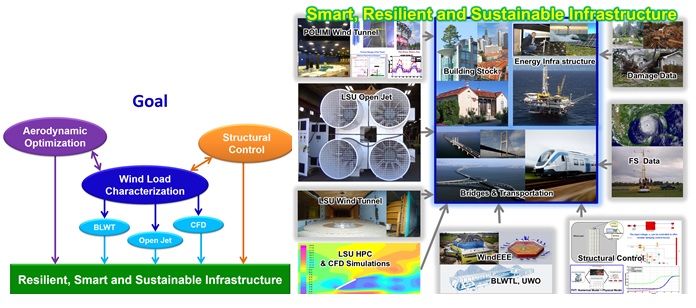Wind Engineering and Science for Smart, Resilient, and Sustainable 21st Century Infrastructure
Louisiana State University
Problems
With the current climate change, monster windstorms could become more destructive than before. Given the loss of life and property, it is crucial to build the more resilient community. Consequently, our research focuses on expanding knowledge useful for retrofitting existing infrastructure and building new ones to survive stringent windstorms in an optimal way. To achieve these goals, two important challenges are to be addressed: (1) the reliable characterization of wind impact on the built environment; and (2) the optimal tuning of smart structures and their complex behavior brought by their inherent nonlinearity.
To fully address the first challenge, our research group combines the benefit of state-of-the-art experimental and computational capabilities to correctly simulate the physics incorporated in wind flows around bluff bodies. The research group has access to a wind tunnel facility, small and large-scale open-jet experimental facility, and high performance computing resources for CFD simulations with LES. This research mainly focuses on the appropriate simulation of inflow in atmospheric boundary layer to ascertain evaluating correct peak loads on roofs and other types of structures. The potential applications include the design aspects of the infrastructure for windstorm: residential homes, offshore structures, bridges, transportation infrastructure, energy infrastructure (wind turbines, solar panels, and petrochemical structures), etc. The research activities are beneficial for students, as they provide potential opportunities to learn with direct involvement in real-world applications. In addition, researchers with interests in structural, coastal, mechanical, computer, agricultural and marine sciences can find a fertile environment for innovations that brings science into practice. Furthermore, the data produced are directly applicable to solving challenging industry issues, improving design codes, and helping the government and the insurance agencies to improve their policies. This will lead to sustainable solutions that can improve the performance of the infrastructure under complex hurricane loads, reduce structures' life cycle costs and increase efficiency in design.
To address the second challenge, the WISE research group is working on developing novel control methods that will permit semi-active controller tuning without simulations. This is because the current approach for the evaluation of semi-active controllers' performance requires significant computational effort for multi-degree-of-freedom systems. Therefore, an analytical probabilistic methods are developed as an alternative approach to the current simulation methods. As the result of that, a wide range of controllers can be evaluated in a fraction of a second and optimum control parameters can be adjusted according to the control objectives.

Approach
To address challenge (1), current research at the LSU WISE group is focused on the reliable estimation of peak wind induced pressures and forces by computational simulations and open-jet testing, making use of available wind tunnel and full-scale pressure data to develop a hybrid mathematical informatical holistic approach for dealing with scale issues in the simulation of wind flows on buildings.
Challenge (2) is being addressed through the development of mathematical formulae that can measure the performance of semi-active controllers without simulations. This is to consider multi-degree-of-freedom structures exposed to multi-hazard loadings. The outcome of this would allow semi-active control designs to become more efficient and more effective by allowing for many more potential primary controllers to be considered in the design process.
Impact
This research has the potential to expand knowledge and create science in the area of wind engineering and structural control, useful to achieve the ultimate goal of building resilient, smart and sustainable infrastructure to survive under multi-hazards brought by natural disasters and other types of stressors. This will broadly impact the wind/structural engineering research field, and facilitate effective investments in the infrastructure industry that will result in more resilient and sustainable communities and contribute to economic growth, and improve the quality of life.
Core competencies
- Multi-Scale Experimental/Computational Wind Engineering: (Wind Tunnel and Open-Jet Testing, CFD Simulations);
- Improved Performance/Resiliency of the Built Environment under Windstorm Forces: (New and Existing Infrastructure: Low-Rise Buildings, Tall Buildings, Bridges, Power Transmission Lines and Towers, Solar Panels, Wind Turbines, Offshore Structures, Green Building Envelope, etc.);
- Structural Dynamics/Control/Mitigation under Wind and Earthquake Loads: (Smart Structures and Probabilistic Dissipative Analysis).
Current & past research group members
- Aly-Mousaad Aly (Faculty)
- Milad Rezaee (PhD Student)
- Hamzeh Gol Zaroudi (PhD Student)
- Suvash Chapain (M.S. Student)
- Marc Huffman (M.S. Student)
- Jennifer Whipple (M.S. Student)
- Raymond Poche (U.G. Student)
- Laura Iverson (PDP Engineer, BASF Corp)
- Srinivasa Abburu (Engineer)
- Amar Cumorovic (Engineer, CDI Corp)
- Brian Carrington (Engineer, HKS, Inc)
- Mujahed Shalabi (Engineer, LA DOTD)
- Joseph Bresowar (U.G. Student)
- Lisa Goodgion (U.G. Student)


